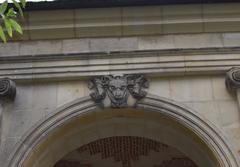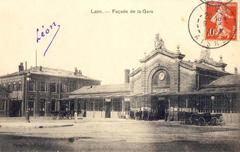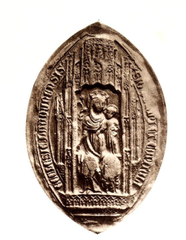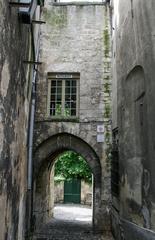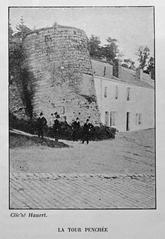
Abbey of St Vincent Laon: Visiting Hours, Tickets, and Historical Significance
Date: 04/07/2025
Introduction
Perched atop a limestone hill in the medieval city of Laon, France, the Abbey of St. Vincent is a monumental testament to over fourteen centuries of religious devotion, architectural evolution, and cultural heritage. Founded around 589 CE—traditionally attributed to the Merovingian Queen Brunehaut—the abbey has played a central role in the spiritual, intellectual, and economic life of northern France. Its enduring legacy is visible today in its surviving fortified enclosures, the elegant 18th-century abbot’s residence, and the archaeological remains that whisper of a vibrant monastic past (Religiana; Monumentum).
This guide provides a comprehensive overview of the Abbey of St. Vincent’s history, architecture, visiting information, and travel tips. Whether you are a history enthusiast, architecture aficionado, or a curious traveler, the abbey offers an enriching journey through the heart of France’s medieval and spiritual heritage.
Table of Contents
- Early Foundations and Merovingian Origins
- Medieval Expansion and Architectural Evolution
- Turbulence, Destruction, and Rebuilding
- The Maurist Reform and 18th-Century Renaissance
- Revolution, Secularization, and Military Use
- Surviving Features and Archaeological Significance
- Architectural and Artistic Features
- Historical and Cultural Significance
- Visiting Information: Hours, Tickets, Accessibility
- Travel Tips and Nearby Attractions
- Enhancing Your Visit: Walks and Events
- Frequently Asked Questions (FAQ)
- Summary and Final Tips
- References
Early Foundations and Merovingian Origins
The Abbey of St. Vincent traces its origins to 589 CE, when Queen Brunehaut—a formidable Merovingian ruler—was said to have founded the monastery on the heights of Laon (Religiana). Early monastic life centered on prayer, study, and agricultural work, establishing the abbey as a vital spiritual and economic hub. The first substantial church was constructed in the 11th century under Abbot Rénier, marking the beginning of its architectural legacy (Monumentum).
Medieval Expansion and Architectural Evolution
Significant growth occurred during the 12th and 13th centuries. Under Abbot Adalbéron, the abbey was fortified and a chapel to Mary Magdalene was added. After a devastating fire in 1145, a major Gothic reconstruction commenced under Abbot Hugues (1175–1205), introducing ribbed vaults, pointed arches, and expansive stained-glass windows (Tourisme Pays de Laon). The fortified walls and semi-domed towers served both spiritual and defensive functions, while new conventual buildings and cloisters supported an expanding Benedictine community (Religiana).
Turbulence, Destruction, and Rebuilding
Throughout its history, the Abbey of St. Vincent endured repeated adversity. It suffered destruction during Viking raids in the 9th century, the Hundred Years’ War, and the Wars of Religion. The church was ravaged by fire in 1145 and again in 2008, and a vault collapse in 1612 further challenged the monks’ resolve (AIM25; Monumentum). Despite these setbacks, the abbey community persisted, rebuilding and adapting across centuries.
The Maurist Reform and 18th-Century Renaissance
In 1640, the Congregation of Saint-Maur revitalized the abbey with extensive repairs and new construction. The abbot’s residence, rebuilt in 1771 in a refined U-shaped limestone style, is a prominent surviving feature (Monumentum; Religiana).
Revolution, Secularization, and Military Use
The French Revolution dramatically altered the abbey’s destiny. Seized and secularized in 1793, it became a military hospital and later a detention center, before much of the complex was sold and demolished by 1810. Only the abbot’s residence and a single tower survived. The French Army acquired the site in 1876, converting it into an arsenal—a function it retained through the 20th century (Monumentum).
Surviving Features and Archaeological Significance
Today, visitors can explore the fortified enclosure, the abbot’s residence, guest buildings, the monastic pond (noted by Buffon for its unique water level), wells, underground passages, and caves (Monumentum). Archaeological excavations, notably in 2021, have shed further light on the abbey’s layered history. Interpretive panels throughout the grounds provide valuable context (Tourisme Pays de Laon).
Architectural and Artistic Features
Romanesque and Gothic Foundations
The abbey’s original Romanesque character is evident in robust masonry, rounded arches, and thick walls. The Gothic transformation introduced pointed arches, ribbed vaults, and luminous stained-glass windows, especially in the choir and transept (choosewhere.com).
Notable Elements
- Nave and Choir: The nave features Romanesque solidity transitioning into Gothic verticality in the choir, with ribbed vaults and clerestory windows.
- Transept and Crossing: Short transept arms boast rose windows and medieval glasswork; the crossing is topped by a modest lantern tower.
- Cloister and Monastic Buildings: Remnants of the cloister and chapter house still exhibit decorative capitals and ribbed vaults.
Artistic Highlights
- Sculpture and Carvings: Tympanum and capitals depict biblical scenes, saints, and fantastical creatures, blending Romanesque stylization with early Gothic realism.
- Stained Glass: Surviving glass fragments in the choir and transept depict saints and biblical events.
- Frescoes: Faded wall paintings in the apse and chapels once illustrated scriptural stories and saints.
Decorative Details
- Capitals and Corbels: Carvings feature foliage, scenes of daily life, and allegorical representations.
- Floor Mosaics and Tiles: Medieval mosaics and tiles with geometric and symbolic motifs have been uncovered.
Restoration and Preservation
Substantial restoration in the 19th and 20th centuries stabilized the structure and conserved its artistic elements, with ongoing efforts to document and protect the site (choosewhere.com).
Historical and Cultural Significance
Religious and Scholarly Role
The abbey’s scriptorium was renowned for manuscript production, helping to preserve both religious texts and classical learning (Encyclopedia Britannica). Its library attracted scholars from across France, cementing its status as a center of theological and intellectual activity.
Pilgrimage and Community Impact
Devotion to St. Vincent of Saragossa fostered a pilgrimage tradition, with annual feast days and rituals drawing both nobility and commoners (Laon Tourisme; Nominis). The abbey’s economic and charitable work further contributed to the region’s well-being.
Regional and National Identity
The abbey’s prominence in medieval chronicles and its ties to royal and episcopal patronage highlight its importance in the history of Picardy and France as a whole (Patrimoine-Histoire).
Visiting Information: Hours, Tickets, Accessibility
Visiting Hours: The Abbey of St. Vincent is generally open for exterior visits Tuesday to Sunday, from 10:00 AM to 6:00 PM (last entry 5:30 PM). Hours may vary due to restoration or special events—always check the official tourism website or the Laon Tourist Office for the latest information.
Tickets: Entry to the grounds is typically free. Guided tours and museum access may require a fee (usually under €10 per adult), with discounts for students, seniors, and children. Advance booking is advised during peak seasons.
Accessibility: Main exterior areas are wheelchair accessible. Some historic sections, such as cellars and upper levels, may be less accessible. Contact the site in advance to arrange special accommodations.
Facilities: Public restrooms, cafés, and picnic areas are located nearby in the old town. The abbey is within easy reach of the city center and other major attractions (parisplusplus.com).
COVID-19 Measures: Check the latest health and booking policies before your visit.
Travel Tips and Nearby Attractions
- Combine Your Visit: Explore Laon Cathedral, medieval ramparts, the city’s museums, and the historic city walls.
- Arrival: Laon is accessible by train and car; local buses serve the old town.
- Tours: Guided tours (booked via the Tourist Office) and audio guides are highly recommended.
- Photography: Allowed in most areas; check for restrictions in the museum or during events.
- Footwear: Wear comfortable shoes for uneven surfaces and walking tours.
Enhancing Your Visit: Walks and Events
- Heritage Walks: The Tourist Office offers mapped walking routes through Laon’s medieval core, featuring panoramic viewpoints and historic gates (parisplusplus.com).
- Events: Look out for classical concerts, art exhibitions, and historical reenactments at the abbey and in Laon’s old town—especially during summer festivals (overyourplace.com).
- Museum: Visit the on-site museum for medieval manuscripts, religious art, and artifacts (wildtrips.net).
Frequently Asked Questions (FAQ)
Q: What are the Abbey of St. Vincent’s opening hours?
A: Tuesday to Sunday, 10:00 AM to 6:00 PM (last entry 5:30 PM). Hours can vary; always check in advance.
Q: How much are tickets?
A: Exterior access is free. Guided tours and museum entry cost under €10 per adult, with concessions.
Q: Is the abbey accessible for visitors with disabilities?
A: Most exterior areas are accessible; contact the site for special arrangements.
Q: Are guided tours available?
A: Yes, guided and audio tours are offered—advance booking is recommended.
Q: Can I take photographs?
A: Photography is permitted in most areas, with some restrictions in the museum.
Q: What nearby attractions should I visit?
A: Laon Cathedral, the city ramparts, underground tunnels, and local museums.
Summary and Final Tips
The Abbey of St. Vincent in Laon embodies the enduring spirit of France’s medieval heritage, from its Merovingian roots to its Gothic splendor and modern preservation. The abbey’s surviving architecture, artistic treasures, and tranquil setting offer a profound connection to the past (Monumentum; Tourisme Pays de Laon). With practical visitor amenities, guided tours, and proximity to other historic sites, your visit can be as immersive and rewarding as you wish (choosewhere.com; parisplusplus.com).
For the most up-to-date information, download the Audiala app, consult the official tourism website, and follow Laon’s social media channels. Plan your journey to discover centuries of history, art, and faith in one of France’s most evocative medieval settings.
References
- Tourisme Pays de Laon: Abbey of St. Vincent
- choosewhere.com: Laon Visitor Guide
- Laon Tourisme: Abbey of St. Vincent
- parisplusplus.com: Laon Hilltop City
- Monumentum: Abbey of St. Vincent
- AIM25: Abbey of St. Vincent in Laon
- Encyclopedia Britannica: Monasticism
- Structurae: Abbey of St. Vincent Data
- Nominis: St. Vincent of Saragossa
- Patrimoine-Histoire: Laon Saint Vincent
- wildtrips.net: Laon Top 10 Attractions
- fr.wikipedia.org: Abbaye Saint-Vincent de Laon
- overyourplace.com: Laon Travel Guide
- francethisway.com: Laon guide







